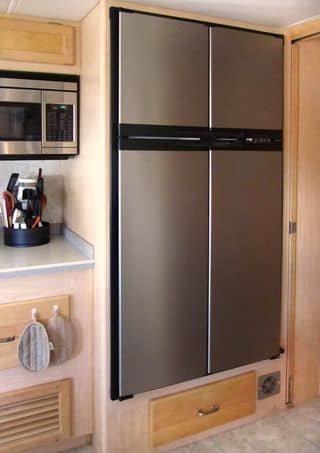Understanding Your RV’s Refrigerator

Understanding Your RV’s Refrigerator
Posted on: March 2, 2017
An RV refrigerator can be one of the most confounding pieces of equipment for an RV owner to learn how to use. You would think that a seemingly simple and straightforward appliance like a refrigerator shouldn’t be any cause for anxiety or problems. But an RV fridge is slightly different than the one in your home kitchen, and there are a few unique things you need to understand before you can properly operate fridge in your rig.
Here is a quick primer on how your RV fridge works and some tips to keep it at optimal performance:
- Your fridge can operate on electricity or propane gas. To run the unit on electricity, your RV needs to be connected to a power source. Keep in mind that using a thin extension cord may not be able to supply enough energy for the fridge to cool. To run your fridge on gas, you may only have to flip a switch from electric to gas. However, air may be in the gas lines and getting the fridge propane element to light may be difficult. To purge the gas line of any air bubbles, light one of the burners on your stove before flipping the gas switch on your fridge. Be patient – it could take a few tries before the unit lights.
- Unlike your trusty refrigerator at home that has a compressor and moving parts to cool the unit, the fridge in your RV operates off of a different cooling method. It relies on the principle of absorption, where heat from inside the unit is removed (or absorbed) to create a cool environment. To achieve this, the fridge in your RV comes equipped with a solution that when heated by an electric element or propane gas, draws heat away from the interior via evaporation and condensation.
- For your fridge to cool properly and efficiently, your RV must be level. For newer rigs, the precision leveling isn’t as necessary as with older models, but leveling is still important. This allows the solution inside the fridge to circulate as intended and not pool in the lines, which will happen when the vehicle isn’t level. Keeping the fridge cool when you’re on the road is a bit easier, as the solution will slosh throughout the lines during travel and not have a chance to pool.
- Before you head out on a trip, cool your fridge down the day before so you can pack food in it. When stocking your fridge, pack items that are fresh and already cold. An easy way to ensure this is to cool items in your home refrigerator before packing, and if grocery shopping on the road, grab refrigerated items from the back of a cold case at the store. These items are often the most recently stocked ones and because they are closer to the interior of the cooler, are at the coldest temperature. Loading your RV fridge with food that’s already cold can help ease the burden of cooling on the fridge itself. Additionally, avoid over packing the fridge so air can circulate properly throughout the unit.


